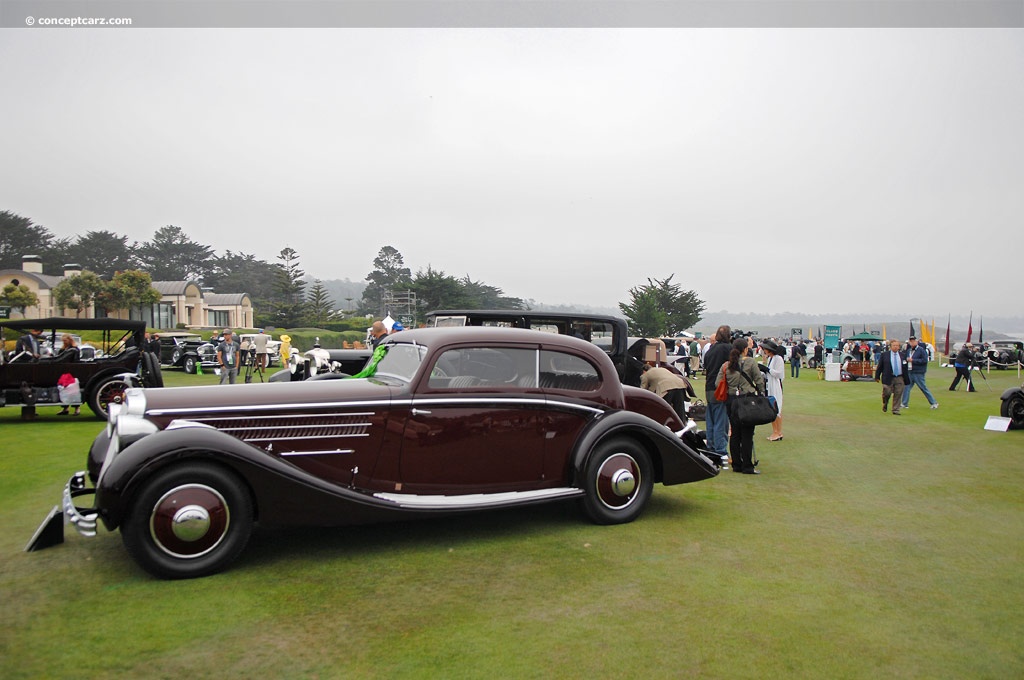Vanvooren was responsible for creating coachwork for 98 of the 204 Hispano-Suiza K6 models built between 1934 and 1937. Power was from a six-cylinder engine displacing 5,200cc and offering 120 horsepower. It was backed by a three-speed manual transmission and had a top speed of around 87 mph. 
Coach Mouette by Henri Chapron
Chassis #: 16069
Engine #: 333192
View info and history
Auction entries : 2This Spanish automotive–engineering company has roots that date to 1898 when La Cuadra was formed by Emilio de la Cuadra. He hired Swiss engineer Marc Birkigt and under his direction, two types of La Cuadra gasoline-powered engine cars were built. Ownership of the company changed hands to José María Castro Fernández in 1902 and became Fábrica Hispano-Suiza de Automóviles. This endeavor was short-lived as it went bankrupt in December of 1903. This was followed by a restructuring, creating La Hispano-Suiza Fábrica de Automóviles, under Castro's direction, also based in Barcelona. The company managed to survive until 1946, in Barcelona and produced cars, buses, trucks, aero engines, and weapons during that time. The company introduced the Hispano-Suiza H6 model in 1919 with an inline 6-cylinder overhead camshaft engine based on its aluminum V8 World War I aircraft engines. During the 1920s and 1930s, the Hispano-Suiza Company built a series of luxury cars powered by overhead camshaft engines. During the 1930s, the V-12 powered cars used pushrod valve action in efforts to reduce engine noise. Hispano-Suiza introduced its K6 model in 1934 at the Paris Auto Salon. It was offered as a rolling chassis powered by a five-liter straight-six engine, derived from an earlier Ballot engine design, and formed from lightweight alloys and high-strength steels. Its design was by Rodolphe Herrmann, who worked with Marc Birkigt on the design time. The chassis was a clone of the larger Hispano-Suiza J12, offered a lower price, and powered by half the number of cylinders. It had a four-wheel braking system that utilized a driveshaft-mounted servo mechanism to multiply the mechanical pressure applied to the brake pedal. Semi-elliptic leaf springs supported both the front and rear axles.
by Daniel Vaughan | Apr 2020

Coach Mouette by Henri Chapron
Chassis #: 16069
Engine #: 333192
View info and history
Auction entries : 2
by Daniel Vaughan | Apr 2020
Related Reading : Hispano Suiza K6 History
Hispano-Suiza was founded in 1909 by Swiss engineer Marc Birkigt and Spanish investors. During World War I, the company designed and produced aircraft engines. After the war, the company returned to automobile manufacturing and in 1919 it introduced the six-cylinder Hispano-Suiza H6. Its overhead camshaft engine was based on features of the V8 aluminum engines used in aircraft during WWI. Demand for....
Continue Reading >>
Continue Reading >>
1937 Hispano Suiza K6 Vehicle Profiles
Recent Vehicle Additions
Performance and Specification Comparison
K6 Specification Comparison by Year
Year
Production
Wheelbase
Engine
Prices
146.50 in.
Related Automotive News

Bugatti: Automotive artistry to admire
From the day it was formed in 1909, Bugatti has embodied exquisite design, with founder Ettore Bugatti hailing from a family of acclaimed artists.
To this day, the brands commitment to excellence extends beyond power output and speed. Because...

1926 Hispano-Suiza H6B Cabriolet And 1974 Shadow DN4 Named Best In Show At The 26th Annual Amelia Island Concours d'Elegance
Jacksonville, FL - A 1926 Hispano-Suiza H6B Cabriolet and 1974 Shadow DN4 were crowned this years Best in Shows on May 23, 2021 at the 26th annual Amelia Island Concours dElegance. Moved from March to May in light of the global pandemic, the...

Hispano Suiza: From legend to reality
Hispano Suiza built more than 12.000 luxury cars between 1904 and 1946.
Its emblem, the stork, pays tribute to the squadron emblem painted on the side of a Hispano-Suiza powered fighter aircraft that had been flown during World War I
Its current...

Exhibit At The Mullin Automotive Museum Presents The Rarest And Most Beautiful Cars From Preeminent French Coachbuilders
Titled Lépoque des Carrossiers The Art and Times of the French Coachbuilders, the exhibit will open on April 14, 2018 and showcase striking examples of hand-built coachwork on some of the most revered and acclaimed cars in the world, including...

MULLIN MUSEUM BRINGING FRANCE'S FINEST TO MONTEREY
The Mullin Automotive Museum to show eight French classics in Monterey, including a 1912 Delaunay-Belleville, Grand Prix cars by Talbot and Delage, two historic Delahayes and a Citroen SM.
Oxnard, Calif. (July 20, 2016) – The Mullin Automotive...
























